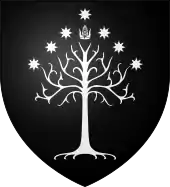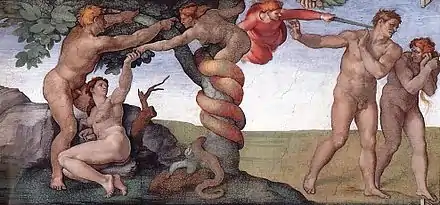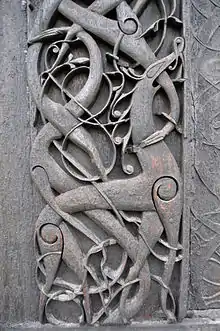Decline and fall in Middle-earth
J. R. R. Tolkien built a process of decline and fall in Middle-earth into his legendarium, prominent in both The Silmarillion and The Lord of the Rings.
The pattern is expressed in several ways, including the splintering of the light provided by the Creator, Eru Iluvatar, into progressively smaller parts; the fragmentation of languages and peoples, especially the Elves, who are split into many groups; the successive falls, starting with that of the angelic spirit Melkor, and followed by the destruction of the two Lamps of Middle-earth and then of the Two Trees of Valinor, and the cataclysmic fall of Númenor.
The whole of The Lord of the Rings shares the sense of impending destruction of Norse mythology, where even the gods will perish. The Dark Lord Sauron may be defeated, but that will entail the fading and departure of the Elves, leaving the world to Men, to industrialise and to pollute, however much Tolkien regretted the fact.
Background
J. R. R. Tolkien was an orphan, his father dying when he was three, his mother, a Roman Catholic, when he was twelve.[1] He was then brought up under the supervision of a Catholic priest, Father Francis Morgan, in industrial Birmingham, which was spreading over the English countryside that he had loved.[2] He remained a devout Catholic all his life, and many Christian themes are visible in his Middle-earth writings.[3] While at Oxford, he joined the informal literary circle of the Inklings, with C. S. Lewis and Owen Barfield among others.[4]
Splintered light
Verlyn Flieger has described the progressive splintering of the first created light, down through successive catastrophes, leaving smaller and smaller splinters as the ages pass. In brief, the creator Eru Iluvatar forms the universe, Eä, with innumerable stars; these light the Earth, Arda, when it is created.[5][T 1]
Angelic beings, the Valar, live in the centre of Arda, lit by two enormous lamps, Illuin and Ormal, atop enormous pillars of rock. The "Years of the Lamps" are abruptly brought to an end when the lamps are destroyed by the fallen Vala Melkor; the powerful fiery light spills out and destroys everything around it. The world is remade with new seas and reshaped continents, no longer symmetrical; the Valar leave Middle-earth for Valinor.[5]
The Vala Yavanna, goddess of plants, does her best to recreate the light, in the form of the Two Trees of Valinor, the silver Telperion and the gold Laurelin; they alternately brighten and dim, overlapping to create periods of "dawn" and "dusk". The light of the "Years of the Trees" is gentler than the lamps, lighting only Valinor: Middle-earth lies in darkness.[5][T 2]
The Two Trees also exude a droplets of light which the Vala Varda (who the Elves call Elbereth) catches in vats; she uses the dew from Telperion to shape bright new silver stars to give at least some light to the Elves of Middle-earth.[5][T 3]
The splintering continues. In the First Age, Fëanor, the most skilled of all Elven-smiths, makes his finest work, the three Silmarils, forged jewels containing some of the light of the Two Trees.[6][T 4]
The making of the Silmarils is timely, as Melkor returns, bringing the insatiable giant spider Ungoliant to devour the Two Trees and absorb all their light into her darkness. These contain the only remaining true light not poisoned by Ungoliant.[6][T 5]

Yavanna and Nienna manage to save the last flower of Telperion, which becomes the Moon, and the last fruit of Laurelin, which becomes the Sun. These splinters of light are formed into ships to cross the sky, steered by spirits.[6][T 6]
The Silmarils are fought over in ruinous wars, as narrated in the Quenta Silmarillion. Eventually all are lost: one ends up in the sea, one is buried in the Earth, and one is sent into the sky: by the grace of Elbereth, it is carried by Eärendil the mariner, forever sailing his ship across the heavens, appearing as the Morning and Evening Star (the planet Venus). The light is still visible, but is now inaccessible to Middle-earth.[6][T 7]
Eventually the splinters become as small as the Phial of Galadriel, which she had filled with light gathered from her fountain as it refracted the light of the Star of Eärendil. The Phial enables Frodo and Sam to defeat the giant spider Shelob, descendant of Ungoliant, on their way to Mordor to destroy the Ring, which contains the power of Sauron, the remaining servant of Melkor on Middle-earth.[7]
Fragmentation of languages and peoples
The Inkling Owen Barfield had a theory of language, described in his 1928 book Poetic Diction, that interested Tolkien, and indeed, as reported by C. S. Lewis, changed his entire outlook. The central idea, connected to Rudolf Steiner's Anthroposophy, was that there was once a unified set of meanings in an ancient language, and that modern languages are derived from this by fragmentation of meaning.[8] Tolkien took the fragmentation of language to imply the sundering of peoples, in particular the Elves. He took the division into Light and Dark Elves from Norse mythology, but went much further, devising a complex pattern of repeated splitting, migrations, and wars between kindred peoples.[9]
Successive falls

The biblical fall of man begins with a perfect created world; an angel is tempted by pride, and falls, becoming a powerful evil spirit; it in turn tempts humans, who fall; they are cast out of the paradise-garden, which they can never re-enter, and must work for their living in the ordinary world. This pattern is mirrored in Middle-earth. The creator, Eru Iluvatar, sings the first music; one of the angelic spirits, Melkor, becomes proud and falls, singing in disharmony, and ruining everything that is made.[T 1] This first fall leads to a sequence of catastrophes, including the destruction of the Lamps, then the Two Trees, then the wars over the Silmarils.[9] Tolkien noted that reflections of the biblical fall of man can be seen in the Ainulindalë, the Kinslaying at Alqualondë, and the fall of Númenor.[T 8]
This pattern represents a profound spiritual pessimism. As a Catholic, Tolkien believed both in the fall of man, and in the redemption of Christians. This redemption might or might not be available, however, to pre-Christian pagans, even if, like Aragorn, they were clearly virtuous. Tolkien shared his pessimistic outlook with Norse mythology, in which he was an expert.[10] Among those myths is Ragnarök, in which the Norse gods, the Æsir are defeated by the giants, and the world is drowned. The Tolkien scholar Tom Shippey writes that the heroic Norse response to such a gloomy picture was defiance, a Northern courage, appearing in The Lord of the Rings as a consistent good cheer, a willingness to keep going and to keep smiling, even in the face of apparent disaster.[11]
Fading of an imagined prehistory

The Tolkien scholar Marjorie Burns notes in Mythlore that the "sense of inevitable disintegration"[12] in The Lord of the Rings is borrowed from the Nordic world view which emphasises "imminent or threatening destruction".[12] She writes that in Norse mythology, this process seemed to have started during the creation: in the realm of fire, Muspell, the jötunn Surt was even then awaiting the end of the world. Burns comments that "Here is a mythology where even the gods can die, and it leaves the reader with a vivid sense of life's cycles, with an awareness that everything comes to an end, that, though [the evil] Sauron may go, the elves will fade as well."[12]
Patrice Hannon, also in Mythlore, states that:
The Lord of the Rings is a story of loss and longing, punctuated by moments of humor and terror and heroic action but on the whole a lament for a world—albeit a fictional world—that has passed even as we seem to catch a last glimpse of it flickering and fading...[13]
In Hannon's view, Tolkien meant to show that beauty and joy fail and disappear before the passage of time and the onslaught of the powers of evil; victory is possible but only temporary.[13] She gives multiple examples of elegiac moments in the book, such as that Bilbo is never again seen in Hobbiton, that Aragorn "came never again as living man" to Lothlórien, or that Boromir, carried down the Anduin in his funeral boat, "was not seen again in Minas Tirith, standing as he used to stand upon the White Tower in the morning".[13] Since he was dead, Hannon writes, this was hardly surprising; the observation is elegiac, not informational.[13] Even the last line of the final appendix, she notes, has this tone: "The dominion passed long ago, and [the Elves] dwell now beyond the circles of the world, and do not return."[13]
Hannon compares this continual emphasis on the elegiac to Tolkien's praise for the Old English poem Beowulf, on which he was an expert, in Beowulf: The Monsters and the Critics, suggesting that he was seeking to produce something of the same effect:[13]
For it is now to us itself ancient; and yet its maker was telling of things already old and weighted with regret, and he expended his art in making keen that touch upon the heart which sorrows have that are both poignant and remote. If the funeral of Beowulf moved once like the echo of an ancient dirge, far-off and hopeless, it is to us as a memory brought over the hills, an echo of an echo.[T 10]
The Lord of the Rings ends with the departure of the last of the Elves from Middle-earth, and the evident dwindling or fading away of all the non-human peoples - the Ents have no Entwives and so are childless; the Dwarves are few; the monstrous Orcs and Trolls that survived the Battle of the Morannon are scattered; the last of the Elves have sailed beyond the Uttermost West to Valinor. The Hobbits are few and might easily be overlooked; the Men of Gondor have a renewal of Elvish blood, one last time, through the marriage of Arwen to their King, Aragorn.[12][13] All that is left is a world of Men, fading from past glories to the world of today, complete with the industrialisation and pollution of the planet that Tolkien so bitterly resented and regretted, as he described in "The Scouring of the Shire".[T 11]
References
Primary
- This list identifies each item's location in Tolkien's writings.
- Tolkien (1977) The Silmarillion, "Ainulindalë"
- Tolkien (1977) The Silmarillion, ch. 1 "Of the Beginning of Days"
- Tolkien (1977) The Silmarillion, ch. 3 "Of the Coming of the Elves and the Captivity of Melkor"
- Tolkien (1977) The Silmarillion, ch. 9 "Of the Flight of the Noldor"
- Tolkien (1977) The Silmarillion, ch. 8 "Of the Darkening of Valinor"
- Tolkien (1977) The Silmarillion, ch. 11 "Of the Sun and Moon and the Hiding of Valinor"
- Tolkien (1977) Quenta Silmarillion
- Carpenter 1981, #131 to Milton Waldman, late 1951
- The Letters of J. R. R. Tolkien, #211 to Rhona Beare, 14 October 1958
- Tolkien, J. R. R. (1984). Christopher Tolkien (ed.). Beowulf: The Monsters and the Critics. The Monsters and the Critics and Other Essays. Houghton Mifflin. pp. 5–48. ISBN 978-0048090195.
- Tolkien (1955) The Return of the King, book 6, ch. 8 "The Scouring of the Shire"
Secondary
- Carpenter 1978, pp. 24, 38.
- Carpenter 1978, pp. 34, 37, 45-51.
- "JRR Tolkien: 'Film my books? It's easier to film The Odyssey'". The Daily Telegraph. Retrieved 15 December 2014.
- Carpenter 1978, pp. 152-155 and passim.
- Flieger 1983, pp. 60-63.
- Flieger 1983, pp. 89-147.
- Dickerson, Matthew (2006). Ents, Elves, and Eriador: The Environmental Vision of J.R.R. Tolkien. University Press of Kentucky. p. 7. ISBN 978-0-8131-7159-3.
- Flieger 1983, pp. 35-41.
- Flieger 1983, pp. 65-87.
- Ford, Mary Ann; Reid, Robin Anne (2011). Bogstad, Janice M.; Kaveny, Philip E. (eds.). Into the West. Picturing Tolkien: Essays on Peter Jackson's The Lord of the Rings Film Trilogy. McFarland. pp. 169–182. ISBN 978-0-7864-8473-7.
- Shippey, Tom (2005) [1982]. The Road to Middle-Earth (Third ed.). HarperCollins. pp. 175–181. ISBN 978-0261102750.
- Burns, Marjorie J. (1989). "J.R.R. Tolkien and the Journey North". Mythlore. 15 (4): 5–9. JSTOR 26811938.
- Hannon, Patrice (2004). "The Lord of the Rings as Elegy". Mythlore. 24 (2): 36–42.
- Kocher, Paul (1974) [1972]. Master of Middle-Earth: The Achievement of J.R.R. Tolkien. Penguin Books. pp. 8–11. ISBN 978-0-14-003877-4.
- Lee, Stuart D.; Solopova, Elizabeth (2005). The Keys of Middle-earth: Discovering Medieval Literature Through the Fiction of J. R. R. Tolkien. Palgrave. pp. 256–257. ISBN 978-1403946713.
Sources
- Carpenter, Humphrey (1978) [1977]. J. R. R. Tolkien: A Biography. G. Allen & Unwin. ISBN 978-0-04-928039-7.
- Carpenter, Humphrey, ed. (1981), The Letters of J. R. R. Tolkien, Boston: Houghton Mifflin, ISBN 0-395-31555-7
- Flieger, Verlyn (1983). Splintered Light: Logos and Language in Tolkien's World. Wm. B. Eerdmans. ISBN 0-8028-1955-9.
- Tolkien, J. R. R. (1955), The Return of the King, The Lord of the Rings, Boston: Houghton Mifflin (published 1987), ISBN 0-395-08256-0
- Tolkien, J. R. R. (1977), Christopher Tolkien (ed.), The Silmarillion, Boston: Houghton Mifflin, ISBN 0-395-25730-1

.jpg.webp)